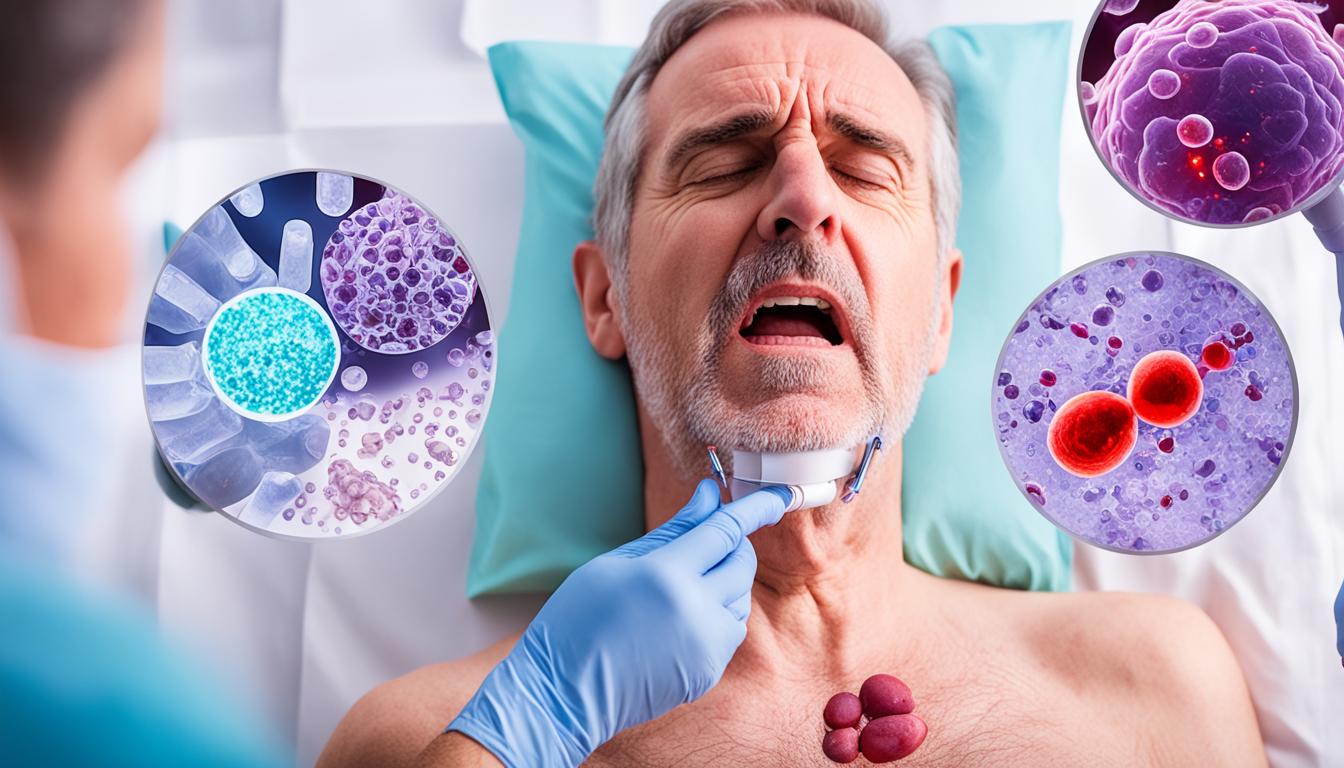Hyperoxaluria and oxalosis are health issues that happen when there’s too much oxalate in the blood and urine. This can form kidney stones or deposit calcium oxalate in organs. Primary hyperoxaluria is rare and happens because the body lacks certain enzymes. This leads to making more oxalate. Secondary hyperoxaluria is not genetic. It can develop when someone eats too much oxalate. Common foods that are high in oxalate include spinach, rhubarb, nuts, and tea. The gut bacteria Oxalobacter formigenes affects oxalate levels too.
To diagnose hyperoxaluria, doctors look at kidney stones, check oxalate levels in urine and blood, and may do genetic tests. Treatment includes changing your diet, taking specific medicines, or sometimes having a liver or kidney transplant. A new treatment using stem cells is also being studied. It aims to help repair damaged tissues and make kidney function better.
Key Takeaways:
- Hyperoxaluria and oxalosis lead to high oxalate levels in the blood and urine.
- Primary hyperoxaluria is a rare, genetic disorder, while secondary hyperoxaluria comes from diet or certain health issues.
- Foods rich in oxalate like spinach, rhubarb, nuts, and tea can make hyperoxaluria worse.
- Doctors diagnose the condition by looking at kidney stones, checking oxalate levels, and genetic tests.
- Treatments include changing what you eat, taking medicines, and possibly using stem cell therapy.
Symptoms and Complications of Hyperoxaluria and Oxalosis
Hyperoxaluria and oxalosis come with many symptoms and issues. They are often about kidney stones and oxalate buildup. People might notice they get urinary tract infections a lot. Blood in the urine, flank pain, and passing small, hard crystals in their urine are other signs.
These problems are linked with making kidney stones from calcium oxalate. In severe situations, oxalate buildup might cause nephrocalcinosis. This is when the kidneys get hard and calcified.
Left untreated, these kidney-related issues can lead to kidney failure. This could mean needing dialysis or a new kidney. Oxalate can also build up in places like bone marrow. This can cause blood problems like pancytopenia and leukoerythroblastic reaction.
Complications of Hyperoxaluria and Oxalosis:
- Nephrolithiasis: Formation of kidney stones made of calcium oxalate.
- Nephrocalcinosis: Calcification and hardening of the renal parenchyma.
- End-stage renal failure: Progression to severe kidney dysfunction, reuquring dialysis or transplantation.
- Extra-renal manifestations: Oxalate can deposit in other organs, such as the bone marrow. This can lead to problems like pancytopenia and leukoerythroblastic reaction.
Knowing about these symptoms and issues with hyperoxaluria and oxalosis is crucial. Early action and the right treatments are important for managing this condition.
Causes and Risk Factors of Hyperoxaluria and Oxalosis
Genetic and acquired issues can both lead to hyperoxaluria and oxalosis. A rare genetic issue called primary hyperoxaluria is caused by a missing enzyme. This makes the body produce too much oxalate, which gathers in organs.
Secondary hyperoxaluria comes from things like eating too much oxalate or having certain gut problems. Eating oxalate-rich foods like spinach, rhubarb, and nuts can make this condition worse.
Enteric hyperoxaluria is linked to problems with digesting fats in the gut. This can cause the body to absorb more oxalate, leading to health problems.
Vitamin C supplements and some medicines can boost oxalate levels, as can the absence of good gut bacteria. This bacteria helps break down oxalate in the intestines.
Genetic Causes of Hyperoxaluria and Oxalosis
Primary hyperoxaluria is mainly shaped by genetic problems. Issues in certain genes like AGXT can stop enzymes from working right. This leads to primary hyperoxaluria.
| Gene | Associated Enzyme | Glyoxylate Metabolism |
|---|---|---|
| AGXT | Alanine-glyoxylate aminotransferase | Converts glyoxylate to glycine |
| GRHPR | Glyoxylate reductase/hydroxypyruvate reductase | Converts glyoxylate to glycolate |
| HOGA1 | 4-hydroxy-2-oxoglutarate aldolase | Converts 4-hydroxy-2-oxoglutarate to pyruvate and glyoxylate |
Knowing the genetic side of hyperoxaluria is key for its diagnosis and treatment. Genetic testing can pinpoint the exact mutations causing primary hyperoxaluria. This helps in planning the right therapies.
Acquired Causes and Risk Factors
Primary hyperoxaluria is genetic, but things like eating too much oxalate can cause secondary hyperoxaluria. Large amounts of vitamin C and some medicines can also up the risk.
Problems with absorbing fat can lead to enteric hyperoxaluria. This means more oxalate is absorbed, which can harm the body.
Too much vitamin C and some drugs can increase oxalate levels. Without good gut bacteria, oxalate isn’t processed well, also raising the risk.
It’s essential to know the roots and risks of hyperoxaluria and oxalosis. This knowledge is vital for proper diagnosis, management, and treatment.
Stem Cell Therapy for Hyperoxaluria and Oxalosis – A Promising Treatment Approach
Stem cell therapy is changing how we treat hyperoxaluria and oxalosis. It gives new hope to patients with these conditions. This method uses the power of stem cells to fix and grow new kidney tissues.
What’s fascinating is that stem cells can turn into different kinds of cells, such as kidney cells. By putting these cells into kidneys that have hyperoxaluria and oxalosis, we can help the area regenerate. This might make the kidneys work better.
Some studies with animals have shown good things. They suggest that stem cell therapy can lower the amount of oxalate in the kidneys. It could also stop the kidneys from getting worse and even make them work better. But, we need more research to make sure this is safe and works for people.
Because stem cell technology is always improving, there’s a lot of hope in using it to treat hyperoxaluria and oxalosis. This method aims to fix the main problems and help the kidneys make new tissue. It creates new chances for patients, making their lives better.

